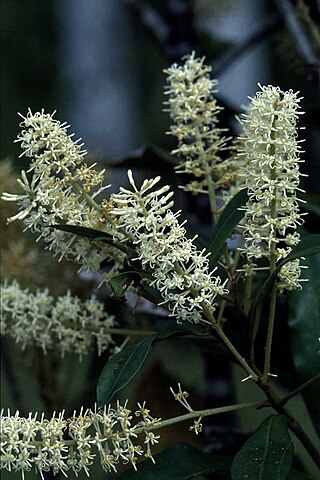Erythrina schliebenii is a species of legume in the family Fabaceae. It is found only in Tanzania. The species is named for German collector and botanist Hans-Joachim Schlieben.

Archontophoenix cunninghamiana – commonly known as Bangalow palm, king palm, Illawara palm or piccabeen palm – is a tree in the palm family Arecaceae, which is endemic to the east coast of New South Wales and Queensland, Australia.
Protomegabaria stapfiana is a species of plant in the family Phyllanthaceae. It is native to western tropical Africa.

Nothorites is a monotypic genus in the macadamia family Proteaceae. The sole species, Nothorites megacarpus, is endemic to the wet tropics rain forests of northeastern Queensland, Australia.

Goniocheton arborescens, commonly known in Australia as Mossman mahogany, is a small tree in the mahogany family Meliaceae. It is native to rainforests of Malesia, Papuasia, Queensland and nearby islands.

Festuca brachyphylla, commonly known as alpine fescue or short-leaved fescue, is a grass native to Eurasia, North America, and the Arctic. The grass is used for erosion control and revegetation. The specific epithet brachyphylla means "short-leaved". The grass has a diploid number of 28, 42, or 44. This species was first described in 1827.

Melhania ovata is a plant in the family Malvaceae.
Melhania velutina is a plant in the family Malvaceae, native to Africa and the Arabian Peninsula.

Brownea macrophylla is a tree in the legume family Fabaceae. The specific epithet macrophylla means 'large-leaved'.
Adenodolichos kaessneri is a plant in the legume family Fabaceae, native to central Africa.
Adenodolichos acutifoliolatus is a plant in the legume family Fabaceae, native to Tanzania.
Adenodolichos punctatus is a plant in the legume family Fabaceae, native to tropical Africa.
Adenodolichos rupestris is a plant in the legume family Fabaceae, native to tropical Africa. The specific epithet means 'found near rocks', referring to where the species was initially encountered.
Adenodolichos baumii is a plant in the legume family Fabaceae, native to tropical Africa.
Adenodolichos exellii is a plant in the legume family Fabaceae, native to tropical Africa.
Adenodolichos huillensis is a plant in the legume family Fabaceae, native to Angola and Zambia.
Adenodolichos rhomboideus is a plant in the legume family Fabaceae, native to tropical Africa.

Tylecodon paniculatus, also known as butter bush, butter tree, butterboom or rooisuikerblom (Afrikaans), is a species of succulent plant in the genus Tylecodon belonging to the family Crassulaceae.

Rubus queenslandicus, commonly known as bramble-of-the-cape, rose-leaf bramble, or native raspberry, is a plant in the rose family Rosaceae which is endemic to a small part of northeastern Queensland, Australia, where it is found on the margins of highland forest. Prior to 1997, collections of this plant were identified as either R. rosifolius, R. fraxinifolius or R. muelleri/R. probus.

Aglaia ferruginea, commonly known as rusty boodyarra or rusty Aglaia, is a plant in the mahogany family Meliaceae that is native to northern Queensland, Australia. The name A. tomentosa has been misapplied to the species in the past.








